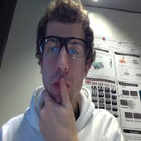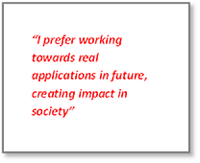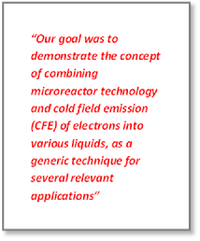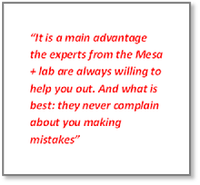 In this thesis a novel process is described combining microreactor technology and cold field emission (CFE) of electrons into various liquids. By doing so, aromatic hydrocarbons can be partially reduced in a new way. ‘This is an important step in various processes in pharmaceutics,’ says Mattia Morassutto. ‘Our goal was to demonstrate the concept as a generic technique for several relevant applications. Generating solvated electrons into a liquid, by applying a relatively low potential in a microreactor, to perform catalyst-free chemical reactions, is a nice idea with a fair degree of relevance.’
In this thesis a novel process is described combining microreactor technology and cold field emission (CFE) of electrons into various liquids. By doing so, aromatic hydrocarbons can be partially reduced in a new way. ‘This is an important step in various processes in pharmaceutics,’ says Mattia Morassutto. ‘Our goal was to demonstrate the concept as a generic technique for several relevant applications. Generating solvated electrons into a liquid, by applying a relatively low potential in a microreactor, to perform catalyst-free chemical reactions, is a nice idea with a fair degree of relevance.’
For a microreactor with nanostructured electrodes, field emissions in liquids containing a proton donator was experimental proven. ‘This was a clear result,’ Mattia says. ‘There are still aspects to improve and to be investigated. However, low voltage charge injection from a field emitter array, integrated in a microchannel, into a flow was proven. At high enough voltages electron emission became predominant with respect to electrochemical conduction here.’
Mattia Morassutto started his PhD project creating vertically aligned nanotubes suitable for field emission applications. After that, a novel microreactor with photolithographically defined integrated electrodes was first analyzed, using a linear microtip array and a flat electrode. ‘With this field emission microreactor, aromatic hydrocarbons could be reduced, though a proton donator adding was still necessary,’ he says. ‘For tip-to-flat electrode distances of less than 3 µm, field emission was identified.’
In the last chapter Mattia describes partial hydrogenation of polycyclic aromatic hydrocarbons by using the microreactor with nanostructured electrodes. Applying a potential difference of only 10-25 volts, led to conversions to be expected. ‘The performance still is relatively low,’ Mattia says. ‘This can be explained by the small residence times obtainable in the microreactor.’
Lab experts

In this PhD project Mattia, as a member of the Mesocale Chemical Systems Group, collaborated with the Mesa+ Group: Physics of Interfaces of Nanomaterials. ‘Also I collaborated with several technicians from the Mesa+ Lab,’ he says. ‘It is a main advantage these expert people are always willing to help you out. And what is best: they never complain about you making mistakes. In this way PhD’s are facilitated to gain important cleanroom know-how and experience.’
Industry
Being an industrial chemist originally, Mattia was introduced to a lot of new physics to be learned and experimental hands-on techniques. ‘Now, I like physics more, but still, at times, I am quite scared by it,’ he says smilingly. 
Mattia prefers a job in industry, be it in a small or big company. ‘I worked in industry before, and I very much like to improve products, constantly working on their performance and quality. In academics there is always a need to go deeper into understanding all processes and details involved. Every day, that is. A certain type of personality is needed to do so. One is sometimes losing sight of the real purpose for future applications, I believe. I prefer working closer towards these real applications in future, creating impact in society.’
